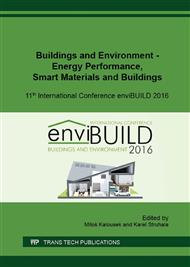[1]
A. Bolattürk, Determination of optimum insulation thickness for building walls with respect to various fuels and climate zones in Turkey, Appl. Therm. Eng. 26 (2006) p.1301–1309.
DOI: 10.1016/j.applthermaleng.2005.10.019
Google Scholar
[2]
J. Nyers, P. Komuves, Optimum of External Wall Thermal Insulation Thickness using Total Cost Method, In: EXPRES 2015 Subotica, 7th International Symposium on Exploitation of Renewable Energy Sources and Efficiency, 2015. 03. 19-2015. 03. 21, Subotica, pp.13-17.
Google Scholar
[3]
Á. Lakatos, Moisture induced changes in the building physics parameters of insulation materials, Sci. Technol. Built. En. 21 (2016) 1-13.
Google Scholar
[4]
F. Szodrai, Á. Lakatos, Simulations of the Changes of the Heating Energy Demand and Transmission Losses of Buildings in Central European Climate: Combination of Experiments and Simulations, Int. Rev. Appl. Sci. Eng. 6 (2015) pp.129-139.
DOI: 10.1556/1848.2015.6.2.6
Google Scholar
[5]
Á. Lakatos, Comparison of the thermal properties of different insulating materials, Adv. Mat. Res. 899 (2014) pp.381-386.
DOI: 10.4028/www.scientific.net/amr.899.381
Google Scholar
[6]
M. Fordham, Natural ventilation, Renew. Energ. 19 (2000) pp.17-37.
Google Scholar
[7]
T. Schulze, U. Eicker, Controlled natural ventilation for energy efficient buildings, Energ. Buildings 56 (2013) p.221–232.
DOI: 10.1016/j.enbuild.2012.07.044
Google Scholar
[8]
C. Allocca, Q. Chen, L.R. Glicksman, Design analysis of single-sided natural ventilation, Energ. Buildings 35 (2003) p.785–795.
DOI: 10.1016/s0378-7788(02)00239-6
Google Scholar
[9]
R. Yao, B. Li, K. Steemers, A. Short, Assessing the natural ventilation cooling potential of office buildings in different climate zones in China, Renew. Energ. 34 (2009) p.2697–2705.
DOI: 10.1016/j.renene.2009.05.015
Google Scholar
[10]
C. Afonso, A. Oliveira, Solar chimneys: simulation and experiment, Energ. Buildings 32 (2000) p.71–79.
DOI: 10.1016/s0378-7788(99)00038-9
Google Scholar
[11]
7/2006 TNM Decree on the energy performance of buildings.
Google Scholar
[12]
Information on: https: /www. ksh. hu/docs/eng/xstadat/xstadat_annual/i_zhc015a. html.
Google Scholar
[13]
S. Shun, N. A. Ahmed, Utilizing wind and solar energy as power sources for a hybrid building ventilation device, Renew. Energ. 33 (2008) p.1392–1397.
DOI: 10.1016/j.renene.2007.07.017
Google Scholar
[14]
K. Niachou, S. Hassid, M. Santamouris, I. Livada, Experimental performance investigation of natural, mechanical and hybrid ventilation in urban environment, Build. Environ. 43 (2008) p.1373–1382.
DOI: 10.1016/j.buildenv.2007.01.046
Google Scholar


